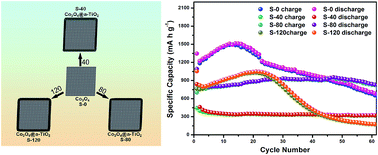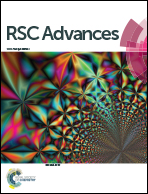Enhancing the electrode performance of Co3O4 through Co3O4@a-TiO2 core–shell microcubes with controllable pore size†
Abstract
Co3O4 is a potential high-capacity anode material for lithium ion batteries (LIBs), but it usually has poor cycling stability due to its enormous volume variation during the conversion reaction process. A protection strategy has been developed to enhance the electrode performance of Co3O4 through construction of Co3O4@amorphous-TiO2 (Co3O4@a-TiO2) core–shell nanostructures with controllable pore size, realized by precisely regulating the volume ratio of ethanol to water. To our knowledge, this is the first time to use core–shell Co3O4@a-TiO2 as the anode material for the lithium-ion batteries. Noteworthy, electrochemical performances of the materials were found to be strongly correlated with their porous structures. With the excellent stability of TiO2 sheath, high capacity of Co3O4 core, and the optimized porous size, these unique Co3O4@a-TiO2 core–shell microcubes exhibit high capacity, long cycle life and good rate capability as advanced electrode materials for lithium-ion batteries. A high reversible capacity of ∼800 mA h g−1 is obtained at 500 mA g−1, keeping the value stable after 60 cycles. We anticipate that such a demonstration presents a versatile method toward synthesizing other high-performance and multifunctional metal oxides@a-TiO2 nanocomposites for LIBs in near future.


 Please wait while we load your content...
Please wait while we load your content...